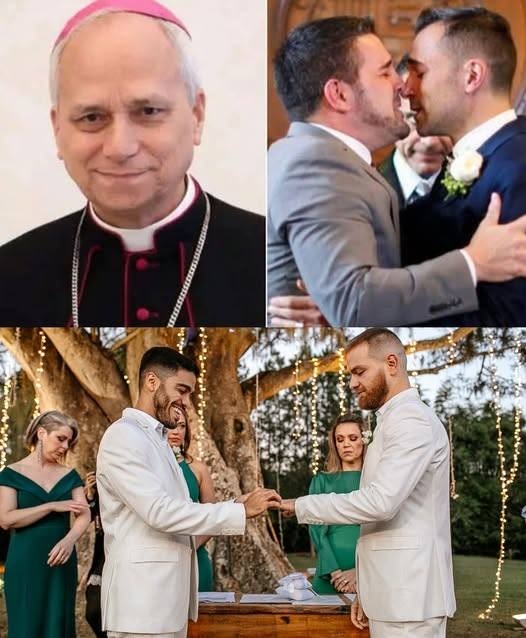Sometimes, a single word can shake the world.
That’s what happened when Pope Leo XIV — newly elected as the first American-born pontiff — stood before a sea of reporters at the Vatican and delivered a message that was as brief as it was baffling.

It happened on May 12, 2025, just days after his election. The Vatican press hall was packed with journalists from every continent, all eager to hear from the 69-year-old former Cardinal Robert Prevost, now the 268th leader of the Catholic Church. Cameras flashed, translators waited, pens hovered above notebooks. When a reporter shouted, “Holy Father, do you have a message for the United States?” the new pope smiled softly, paused for a long moment, and said just one word:
“Many.”
Then, after a simple “God bless you all,” he turned and walked away.
It was over in less than ten seconds — and yet the ripple it caused spread across the globe. Within minutes, “Many” became a trending topic on every social media platform. News anchors debated it. Linguists analyzed it. Theologians and skeptics alike tried to make sense of what seemed like either a profound statement or an unintentional enigma.
The Word That Launched a Thousand Theories
Was it a mistake? A deliberate message? A translation issue?
The Vatican declined to clarify, releasing no official comment. That silence only deepened the mystery — and the fascination.
Almost immediately, three main interpretations began to dominate the public conversation.
1. A Message of Abundance and Blessing
Many Catholics saw it as an expression of spiritual abundance — a way of saying that God’s blessings are “many,” that mercy is “many,” that love, compassion, and forgiveness flow endlessly. To them, it was poetic, intentional, and deeply biblical. “The Pope doesn’t always speak in plain language,” one theologian explained. “Sometimes, a word like ‘many’ invites contemplation. It’s a doorway, not a destination.”
2. An Unfinished Thought
Others speculated that it might have been the beginning of a longer statement — perhaps “many challenges ahead,” “many prayers for America,” or “many reasons for hope.” If that was the case, Pope Leo’s silence afterward could have been deliberate. A kind of rhetorical pause that turned into a statement in itself. Great orators have used silence as punctuation before; maybe the Pope did the same.
3. A Reflection of America Itself
The most discussed theory was that the Pope’s word was a mirror — a subtle acknowledgment of America’s complexity, its diversity of people, faiths, and struggles. “Many voices. Many beliefs. Many contradictions,” wrote one commentator in La Repubblica. “Perhaps ‘many’ is his way of saying: I see all of you. The unity of the Church must hold space for the many.”
The Global Reaction
Within hours, “#Many” was everywhere. Some joked that the Pope had dropped the shortest sermon in history. Memes flooded X and Instagram — from “The Pope’s new album: Many” to mock press briefings of world leaders trying to decode the message.
But not everyone took it lightly. Scholars in Catholic universities from Boston to Buenos Aires began publishing short essays analyzing the word’s possible theological weight. One pointed out that “many” appears repeatedly in scripture — “many are called, but few are chosen.” Another suggested that the Pope may have been invoking inclusivity: the Church’s mission to welcome “many,” not just the devout few.
Even non-religious circles found meaning in the mystery. Communication experts hailed it as “a masterclass in modern media symbolism.” In a world addicted to long speeches and empty soundbites, one word — ambiguous and open-ended — managed to dominate headlines for days.
A Pope of Few Words
Leo XIV’s minimalism shouldn’t have come as a surprise. Even before his election, Robert Prevost was known inside the Vatican as a pragmatic listener. He spoke little but paid attention deeply. A Chicago native with decades of service in Peru and the Philippines, he had earned a reputation as a bridge-builder — a man who preferred dialogue to decree.
His election as pope was itself a message: a signal that the Church was ready for humility, for leadership grounded in quiet conviction instead of spectacle. So perhaps “Many” wasn’t random at all. Perhaps it was the purest reflection of who he is — concise, contemplative, and unafraid of being misunderstood if it meant provoking thought.
History Has Its Echoes
It wouldn’t be the first time brevity made history. In 1963, Pope John XXIII, when asked what message he had for the world, simply said: “Peace.” It became a defining statement of his papacy.
President Calvin Coolidge was once mocked for saying little, yet his famous “You lose” remark to a reporter remains legendary. And Hemingway’s haunting six-word story — “For sale: baby shoes, never worn.” — proves that silence can speak louder than paragraphs.
When great figures say less, the world listens harder.
Silence as Strategy
In a global media landscape drowning in noise, Pope Leo XIV’s single word forced the public to stop scrolling, to think, to question. It flipped the rhythm of modern communication upside down. People aren’t used to being handed a riddle instead of a press release.
“‘Many’ worked precisely because it didn’t explain itself,” said Father Michael Lang of Georgetown University. “It left space for interpretation — and that’s rare in a world addicted to certainty. Whether by design or instinct, the Pope reminded everyone that not everything sacred can be reduced to a soundbite.”
The Cultural Aftershock
For several weeks after the remark, “Many” inspired think pieces, podcasts, and even art installations. Some designers printed the word on T-shirts alongside minimalist images of the Vatican dome. Musicians sampled the Pope’s brief utterance into ambient tracks titled “The Word.” Religious leaders across denominations discussed it in sermons.
It became, paradoxically, one of the most talked-about papal remarks in decades — not because of what it said, but because of what it didn’t.
The Vatican, true to form, stayed silent. No official explanation ever came. But Leo XIV’s subsequent homilies and speeches hinted at the same themes: unity, diversity, and humility. During Pentecost, he spoke about “the beauty of difference, the holiness of multiplicity.” Many began to see that first mysterious word as the seed of a broader message.
What “Many” Might Still Mean
If you strip away the speculation and memes, what remains is a simple truth: a spiritual leader managed to remind the world that meaning isn’t always found in explanation. Sometimes, it lives in the space between words — the silence that invites reflection.
For Americans, “Many” might mean abundance: the countless lives, faiths, and challenges that define a nation constantly in flux. For believers, it may symbolize the inclusive grace of God — that there is room for many, not just the few. For skeptics, it’s a clever PR move that exposed our hunger to assign meaning to everything.
Maybe it’s all of those things. Maybe that’s the point.
A Word That Endures
Months later, people still quote it, still argue about it, still laugh about it. And that alone makes it powerful. In a time when leaders fill hours with speeches that vanish in minutes, one man said one word — and the world hasn’t stopped talking since.
Whether “Many” was divine inspiration or human accident, it proved something profound about communication in our age: mystery still matters.
Pope Leo XIV’s message — deliberate or not — gave everyone something the modern world rarely offers: a pause.
And in that silence, maybe the word “Many” became what it was always meant to be — an invitation to listen, to think, and to remember that sometimes, the smallest words carry the biggest echoes.


